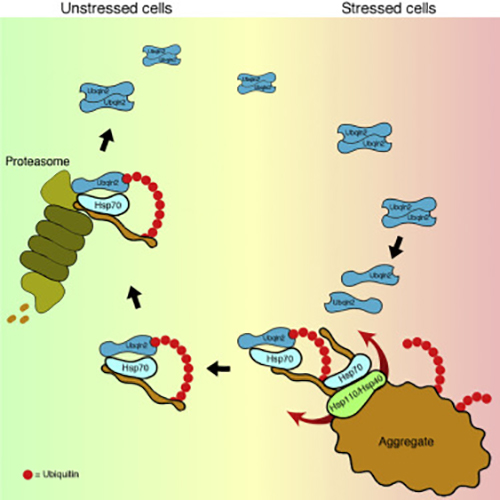![New research has identified how a single gene can protect against the causes of neurodegenerative diseases. [Hjerpe et al., 2016, Cell 166, 1–15]](https://genengnews.com/wp-content/uploads/2018/08/fx11612648126-1.jpg)
New research has identified how a single gene can protect against the causes of neurodegenerative diseases. [Hjerpe et al., 2016, Cell 166, 1–15]
A new study led by investigators at the University of Glasgow has identified how cells protect themselves against misfolded and aggregated proteins known to be the cause of neurodegenerative diseases such as Alzheimer’s, Parkinson’s, and Huntington’s diseases. The researchers are hopeful that the results from this new study will provide needed insight into the biochemical pathways that mediate toxic protein removal and shield the body from disease.
Protein clumps occur as part of the natural aging process, but they are regularly detangled and disposed of as a result of the gene called UBQLN2. However, when this gene mutates, or becomes faulty, it can no longer help the cell to remove these toxic protein clumps, which leads to neurodegenerative disease. In the current study, the researchers utilized an array of cell biology and biochemistry methods, as well as sophisticated mouse models to uncover the primary functions of UBQLN2—detangling clumps, then shredding them to prevent future tangles.
“The function of UBQNL2 is connected to many neurodegenerative disorders, such as Parkinson’s, Alzheimer’s, and Huntington’s diseases,” explained senior study author Thimo Kurz, Ph.D., senior lecturer at the Institute of Molecular, Cell, and Systems Biology within the University of Glasgow. “These patients often have very clear clumps in their brain cells. Using mice that mimic human Huntington’s disease, we found that when UBQLN2 is mutated, it could no longer help nerve cells to remove protein clumps in the brains of these mice.”
Previous work has shown that when the UBQLN2 gene is faulty, it leads to a neurodegenerative disease called amyotrophic lateral sclerosis with frontotemporal dementia (ALS/FTD, or motor neuron disease with dementia). However, until this study, it was not fully understood why mutation of this gene caused disease.
“We describe a new pathway for maintaining protein homeostasis mediated by the proteasome shuttle factor UBQLN2,” the authors wrote. “The 26S proteasome degrades polyubiquitylated substrates by recognizing them through stoichiometrically bound ubiquitin receptors, but substrates are also delivered by reversibly bound shuttles. We aimed to determine why these parallel delivery mechanisms exist and found that UBQLN2 acts with the HSP70-HSP110 disaggregase machinery to clear protein aggregates via the 26S proteasome.”
The findings from this study were published recently in Cell in an article entitled “UBQLN2 Mediates Autophagy-Independent Protein Aggregate Clearance by the Proteasome.”
The authors continued, stating that “UBQLN2 recognizes client-bound HSP70 and links it to the proteasome to allow for the degradation of aggregated and misfolded proteins. We further show that this process is active in the cell nucleus, where another system for aggregate clearance, autophagy, does not act. Finally, we found that mutations in UBQLN2, which lead to neurodegeneration in humans, are defective in chaperone binding, impair aggregate clearance, and cause cognitive deficits in mice.”
This research sheds light on the specific mechanisms of UBQLN2 activity, but stil leaves open the question of why mutations in this gene are so detrimental to the body. The scientists are hopeful that their findings will pave the way for new research into novel treatment options for patients with neurodegenerative diseases.
“The significance of this discovery goes beyond the role of UBQLN2 in motor-neuron disease with dementia,” noted lead study author Roland Hjerpe, Ph.D., research associate at the Institute of Molecular Cell and Systems Biology. “Our study has revealed a new mechanism by which nerve cells cope with protein clumps in general, which has implications for most neurodegenerative diseases and can open up avenues for new therapeutic interventions to treat these conditions in the future.”



